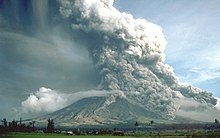
Back Piroklastiese stroom Afrikaans تدفق بركاني فتاتي Arabic Uson BCL Пирокластичен поток Bulgarian আগ্নেয়শিলা প্রবাহ Bengali/Bangla Flux piroclàstic Catalan Pyroklastický proud Czech Pyroklastisk vulkanudbrud Danish Glutlawine German Πυροκλαστική ροή Greek

A pyroclastic flow (also known as a pyroclastic density current or a pyroclastic cloud)[1] is a fast-moving current of hot gas and volcanic matter (collectively known as tephra) that flows along the ground away from a volcano at average speeds of 100 km/h (30 m/s; 60 mph) but is capable of reaching speeds up to 700 km/h (190 m/s; 430 mph).[2] The gases and tephra can reach temperatures of about 1,000 °C (1,800 °F).
Pyroclastic flows are the most deadly of all volcanic hazards[3] and are produced as a result of certain explosive eruptions; they normally touch the ground and hurtle downhill or spread laterally under gravity. Their speed depends upon the density of the current, the volcanic output rate, and the gradient of the slope.
- ^ Branney M.J. & Kokelaar, B.P. 2002, Pyroclastic Density Currents and the Sedimentation of Ignimbrites. Geological Society of London Memoir 27, 143pp.
- ^ "MSH Pyroclastic flow [USGS]". pubs.usgs.gov.
- ^ Auker, Melanie Rose; Sparks, Robert Stephen John; Siebert, Lee; Crosweller, Helen Sian; Ewert, John (2013-02-14). "A statistical analysis of the global historical volcanic fatalities record". Journal of Applied Volcanology. 2 (1): 2. Bibcode:2013JApV....2....2A. doi:10.1186/2191-5040-2-2. ISSN 2191-5040. S2CID 44008872.
© MMXXIII Rich X Search. We shall prevail. All rights reserved. Rich X Search